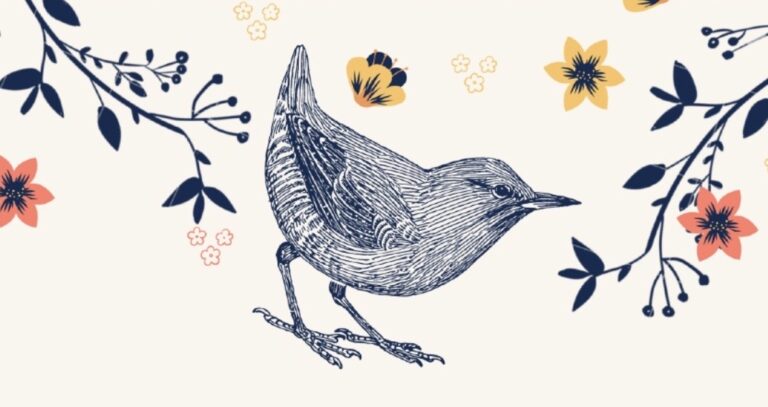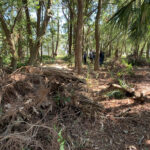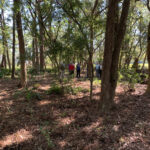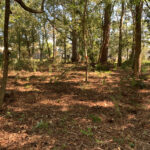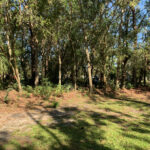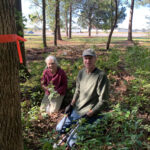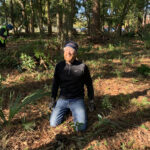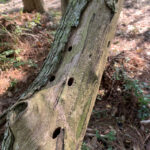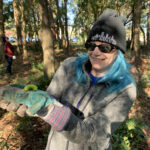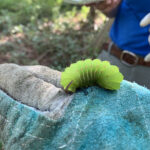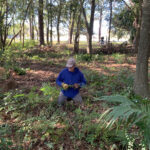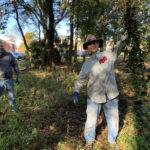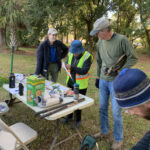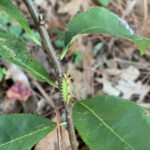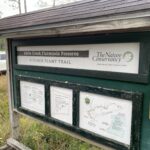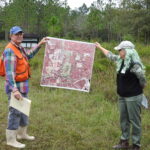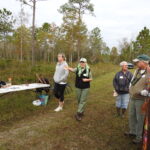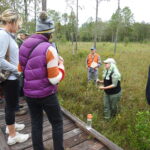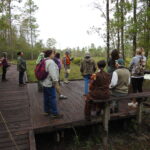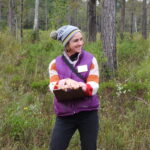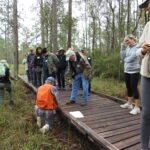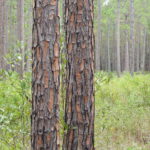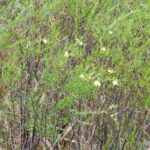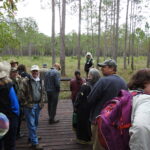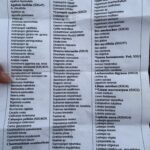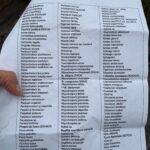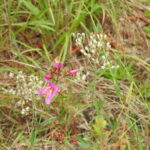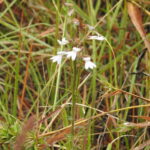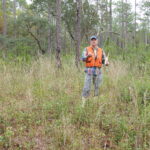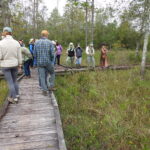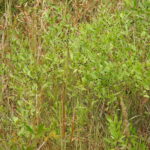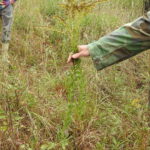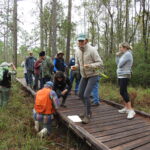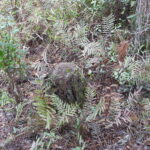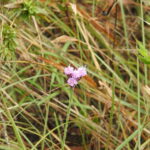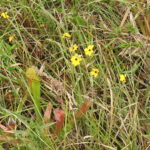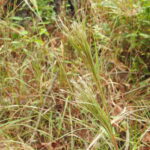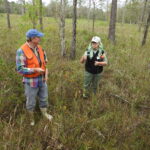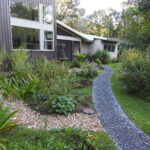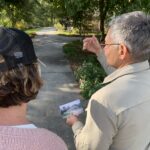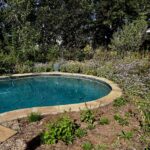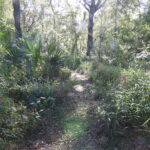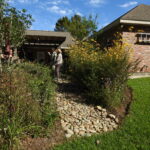UNO has recently completed the terms of a National Fish and Wildlife Foundation grant which enabled the purchase and planting of certain areas of campus that are now part of their Urban Bird Trail. NPI helped coordinate, plan and implement the plantings along with volunteers from Upward Bound Youth Group, Orleans Audubon, Master Naturalists, UNO students and other proactive citizens just wanting to contribute to the birding habitat on campus. In addition to the Woodlot and Quandrant that were part of this volunteer effort, UNO has installed native gardens at two prominent locations on campus, the Administration Building and Fine Arts Building. Below is a list of the numerous native species that can be seen at these locations on campus.
Category: All
Louisiana Certified Habitat Program!
Certify your property as a Louisiana Certified Habitat! Every property, from the smallest city garden to rural acreage, is eligible to apply. 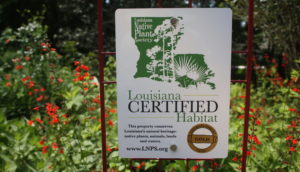
The Louisiana Native Plant Society invites Louisiana residents, businesses, schools, and public institutions to certify their outdoor spaces as certified habitats through the Louisiana Certified Habitat Program (LCH). We know that native plants are the foundation of a healthy and resilient ecosystem. This program encourages property owners to increase and protect the ecological value and natural heritage of their land by recognizing their efforts to utilize native plant species and to enact best habitat gardening practices. Habitat Certification Levels are determined by the amount of native plant species or percentage of native plant species on a property. State-wide, over 140 properties have certified to date, almost 50 in the NOLA area, many electing to appear on the MAP where certifications are being recorded. The levels include bronze, 25 native species or 25% native plants; silver 50 native species or 50% native plants; gold 75 native species or 75% native plants. Certification includes a 9 x 12 inch metal yard sign citing the habitat level. Levels can be upgraded for free at any time. 
The Native Plant Initiative of Greater New Orleans (NPI) certifies the Southeast region of Louisiana. Parishes include: Ascension, Assumption, Jefferson, Lafourche, New Orleans, Plaquemines, St. Bernard, St. Charles, St. Helena, St. James, St. John the Baptist, St. Tammany, Terrebonne, Washington. There is no minimum acreage requirement. All properties are eligible for certification.
How to apply
- Visit LNPS' website to retrieve instructions/application for your area
- Cost is $35.00 for NPI members, 45.00 for non-members
- Fill out an online application a plant checklist is provided
- Upload the native plant checklist and photos of property in online application and submit payment
- OR mail a printed copy of a paper application and native plant checklist as instructed
Payment is due at time of application. When the application and payment are received, a representative from NPI will contact you about the certification process and may request a site visit. A refund will be issued if certification is not granted. Please email npi.gno2019@gmail.com if cost is an issue.
Helpful Links: Native Plant Checklist | Guide to ALL Plants of Louisiana (not all native) | Tier 1 Invasive Species|Full Brochure
UNO Urban Birding Trail gets started with Kick-Off Event…more to come!
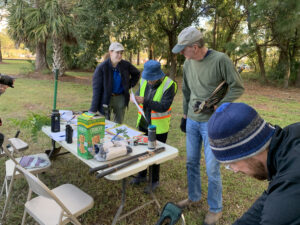
Last Saturday morning in November, we spent a few hours removing invasive tree saplings from the UNO Woodlot. This is the kick-off of a multi-phase project on UNO's campus to enhance bird and wildlife habitat by planting native shrubs and trees to further develop a urban birding trail on campus where over 130 species of birds have already been reported. That’s a lot! With funds granted by the National Fish and Wildlife Foundation, we will be helping to select and plant at least 120 native trees and shrubs in the coming months.
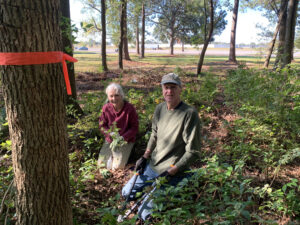
Volunteers came out from NPI, Orleans Audubon, Master Naturalists, UNO faculty and students, former students and community neighbors. We removed lots of Camphor, Golden Rain Tree, Chinese Elm and Tallow saplings that were sprouting on the ground layer of this woodsy spot. We also collected many fallen branches and other forest litter and concentrated them into several brush piles (which birds love!) While we were there, we could hear and see several bird species cavorting about.
We documented the following plant species already on the site:
- Slash Pine
- Black Cherry
- Cherry Laurel
- Live Oak
- Water Oak
- other Oak? (not sure which species)
- Southern Red Oak
- Hickory?
- Green Ash?
- Sweet Gum
- Bald Cypress on fringes
- Elderberry
- Mulberry
- Magnolia, Yaupon and Ilex opaca seedlings
- Virginia Creeper
- Poison Ivy
- Spiderwort
- Bidens alba
- Sida rhombifolia
Now, to decide what 50 native species of tree or woody shrub would best improve the area for birds and fit with the existing plants……What do YOU think we should plant?
Spooky Plant Walk in Abita Creek Flatwoods Preserve
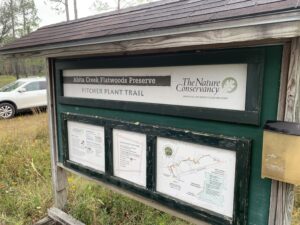
The day before Halloween, NPI President, Tammany Baumgarten, and Board Director Cheryl Geiger made the trek to St. Tammany Parish to attend a guided walk in the Abita Creek Flatwoods Preserve hosted by the Land Trust for Louisiana. Biologists, Nelwyn McInnis and Latimore Smith guided about 20 participants on a boardwalk stroll through a wet longleaf pine savanna grassland, highlighting the natural history and special features. The preserve is described by the Nature Conservancy as a “premiere wetland community with pond cypress woodland, riparian forest, and carnivorous plants.” Land Trust for Louisiana’s conservation easement on the preserve is part of a joint effort with The Nature Conservancy to protect 950 acres of Longleaf pine habitat.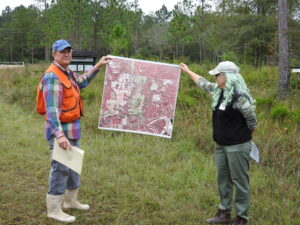
We started our walk on a misty Hallows eve morning, following behind Nelwyn and Latimore, and they explained how hydrology and fire play an important role to create this unique landscape. The seasonality of the wetlands and the undulating ridges and swales support a diverse ecosystem with over 300 species of plants, including rare and endemic species! They explained how historically spring lightning strikes set the savannah ablaze and that the plant community here was adapted to the seasonal burning and relies on it. For example the Longleaf pine, a keystone species in this ecosystem, requires fire to open its pine cones.
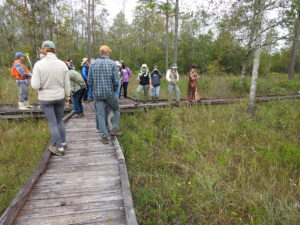 The group slowly walked the boardwalk, asking the knowledgeable biologists questions about flora and fauna identification, land management, and the further conservation efforts of Abita Flatwoods Creek preserve. We got to see carnivorous pitcher plants and sundews up close, enjoyed fall blooming flowers, and learned what makes this landscape rare and worth protecting! Visit Land Trust for Louisiana | Land Conservation to check out the good work they are doing at Abita Creek Flatwoods Preserve and through the state!
The group slowly walked the boardwalk, asking the knowledgeable biologists questions about flora and fauna identification, land management, and the further conservation efforts of Abita Flatwoods Creek preserve. We got to see carnivorous pitcher plants and sundews up close, enjoyed fall blooming flowers, and learned what makes this landscape rare and worth protecting! Visit Land Trust for Louisiana | Land Conservation to check out the good work they are doing at Abita Creek Flatwoods Preserve and through the state!
Enjoy the pictures from the day!
-Cheryl Geiger, NPI Board member
Field Trip to the Cajun Prairie
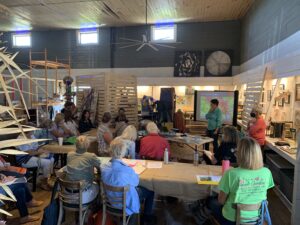
Earlier this month, NPI took a road trip to Arnaudville for Acadiana Native Plant Project’s (ANPP) Yard-to-Habitat workshop. ANPP’s website states that the workshop is “designed to help homeowners and landscapers transform property, from small yards in town to big pastures in the country, to native habitat for pollinators, birds and other wildlife and improve ecological resilience.”
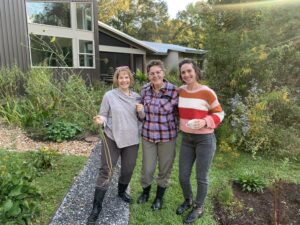
NPI president, Tammany Baumgarten, helped facilitate, working with a break out group on their designs and board members, Tanya Mennear and Cheryl Geiger, attended to learn how to offer this type of workshop in New Orleans. When the plans and plant lists were created, all attendees were invited to visit ANPP’s demonstration garden and greenhouse to purchase plants to be used in their habitat landscapes.
After a stroll through the demo garden and greenhouse, the board members joined some of the ANPP board and organization members at Bayou Teche Brewery for pizza and fellowship, further fostering the relationship between NPI and ANPP. The following day included visits to the incredible home gardens of ANPP leaders Phyllis Griffard and Lawrence Rozas.
ANPP is doing great things over in Acadiana. Check them out!
Top Native Plants for Wildlife in LA

Click on this list of Top Native Plants including trees, shrubs, forbs, and graminoids that are beneficial to Louisiana wildlife.
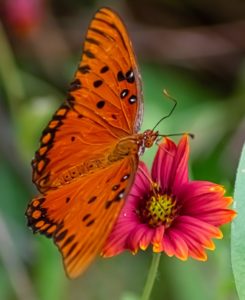 Use these plants in your garden and attract more birds, butterflies, and other animals. Have fun!
Use these plants in your garden and attract more birds, butterflies, and other animals. Have fun!
Going Beyond Sod
Feed the Birds!
Native plants are an important food source to local and migratory birds species. Birds feed on berries, seed heads, nectar, and insects using the plant as a host.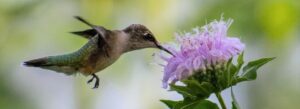
Read more HERE and learn what plants to use to feed the birds in your garden!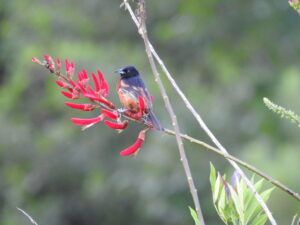
Fall Display: “Strawberry Bush” Euonymus americanus
The Euonymus americana locally know as "Strawberry bush", "Burning Bush", "Hearts-a-Busting" is in full display right now. In late summer/early fall the red fruits burst open to reveal bright orange berries. The pictures below are from a NPI member's garden in New Orleans.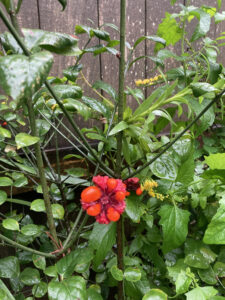
It is an adaptable landscape shrub or small tree tolerating different sun exposures and soil types. It does best in shadier areas with filtered light and protection from afternoon sun. The colorful fruits and seeds not only provide fall interest for humans, but are also a food source for birds and mammals.
In the wild it can be found in riparian areas, forming loose thickets. 
Learn more about the "Strawberry bush" Euonymus americanus HERE
Living with Hurricanes and Native Plants by VP Nell Howard
Once again, a summer hurricane has displayed the inherent and wonderful
qualities of native plants in the landscape.
The live oaks swayed in the 150 mph winds and, if they’ve been maintained
properly, few branches broke. In my back yard, the swamp maple, blooming and
upright cardinal flower, cherry tree, flowering clematis crispa, often visited by
pollinators coral honeysuckle, bee hugging sweet joe pye, black eyed susans and
salvias, and the hummingbird favorite turk’s cap took it all in stride. Louisiana
Irises bent quite a bit, but those can be cut back and/or replanted this time of
year. I’ve noticed the blue jays, hummingbirds, and Carolina wrens returning first,
plus a few strong giant swallowtails and sulphurs. Gulf Coast Fritillaries were
super busy before the storm, and I expect to see more of those shortly.
Watch for power lines! They can be camouflaged in downed tree limbs. Never
touch them. Look for places where water is collecting and empty dishes, gutter
plates, and pots to keep mosquitoes from breeding heavily in all the water left
behind the storms.
Take stock of what weathered the storm well, and be sure to collect those seeds,
where possible. Side dress plants where possible and fertilize if the storm dumped
a lot of rain. Your container plant soils will probably be depleted if they were
rained on heavily for days.
Leave the stalks of your plants that are spent, especially upright stalks of Sweet
Joe Pye and Swamp Sunflowers. Native bees use them as nests over winter, along
with fallen leaves, so blow and rake as little as possible. I’ve heard some people
cut the stalks and lay them horizontally if they’re eyesores, and I’ve not been able
to find any results as to the bees still using horizontal stalks. Experts say to leave
6-18” of upright stalk behind for the bees. Surely we can do that!
Leave the tree cutting to the professionals; but if they are mulching the wood
they cut, ask them for some of the wood chips. Leave them in black plastic bags in
a corner of your yard or house until they compost a bit, then use them in your
garden. Use like chips for like trees, oak chips under oak trees, cypress chips
under cypress trees. I’ve found that a hard root ball and hard pan soil can become
spongy again after a couple of seasons of wood chip mulch applications. Oak trees shed their leaves in storms, so that their branches don’t become overburdened,
and that’s the best free mulch there is. Bag it up and store it, dump some leaves
into your compost bins. Some people like to shred the leaves before using as
mulch, which helps it break down faster. The LA Iris rhizomes and many tender
plants will thank you.
Use this opportunity when the soil is soaked, to remove unwanted invasive plants
like nandina, tallo and elephant ears. These plants are difficult to take out, but
with soggy roots, it’s often easier to dig them out. Hurricanes spread invasive
species, via wind and water, so be on the lookout.
Even if you live in an urban environment, it’s easy to incorporate more and more
natives into your landscape, even if you have a strict HOA. From showy
coneflowers and bright yellow sunflowers (which come in all sizes), to low
growing shady plants like violets and powder puff mimosa groundcovers, to green
shrubs of many native hollies, anise, american beauty berry, wax myrtle or
fetterbush and native trees (which also come in all sizes) like Native Fringe,
parsley haw and Sweetbay Magnolias.
We can do our part to help restore biodiversity, even in our tiniest of gardens:
container gardens, patio gardens, courtyards, driveways, easements. Plant the
native species of plants you love. Replace some of the lawns in your landscape
with islands of native plants, or replace all of your lawn with meandering
pathways of native gardens. Join Doug Tallamy’s Home Grown National Park,
www.homegrownnationalpark.org , or just go plant a few natives.

